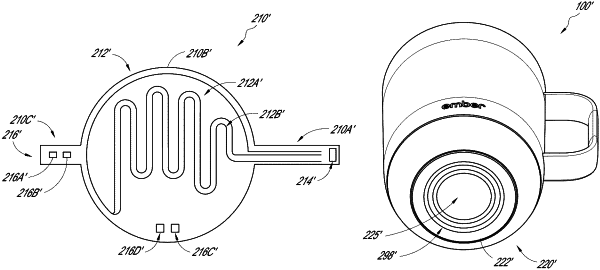| CPC A47G 19/2288 (2013.01) [A47J 41/0044 (2013.01); H05B 1/0244 (2013.01); H04B 1/38 (2013.01); H05B 2203/021 (2013.01)] | 18 Claims |

|
1. An actively heated beverage container system, comprising:
a container having an outer circumferential wall and a chamber configured to hold a liquid defined by an inner circumferential wall and a base attached to the inner circumferential wall, at least a portion of the outer circumferential wall being spaced from the inner circumferential wall to define a gap therebetween;
an end cap coupled to the outer circumferential wall, a cavity defined between the cap and the base, the cap defining a bottom surface of the beverage container; and
a heating element in thermal communication with one or both of the base and the inner circumferential wall to heat at least a portion of the chamber, the heating element comprising one or more heaters that extend along a portion of a generally planar area of the heating element, an extension that extends from the generally planar area having at least two sensors, a second extension that extends from the generally planar area including a connector at an end thereof;
a temperature sensor disposed on the generally planar area, the temperature sensor being spaced apart from the one or more heaters;
control circuitry configured to control operation of the one or more heaters, the second extension of the heating element being connected to the control circuitry via the connector, the control circuitry configured to wirelessly communicate with a remote electronic device; and
at least one power storage element configured to provide power to one or both of the control circuitry and the heating element,
wherein the heating element, temperature sensor, control circuitry and the at least one power storage element are disposed in a cavity between the end cap and the base.
|